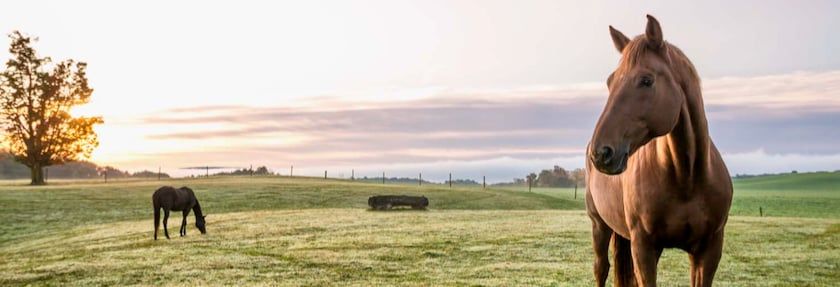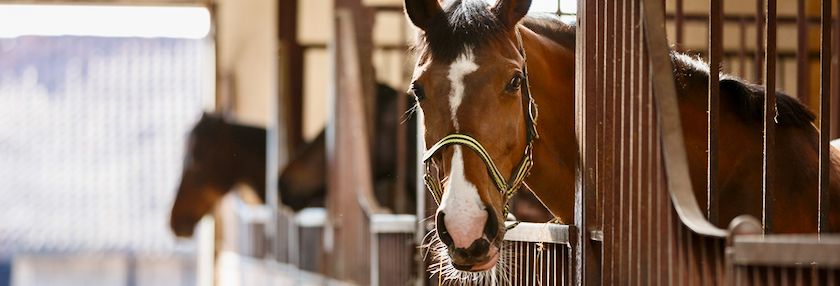Considerations For The Arthritic Horse


Doing the right things keeps your older horses active
Those of us who have grown up riding horses are probably familiar with a persistent stiffness or pain that pops up if we’ve sat too long in a car or are grudgingly climbing out of bed in the morning.
Like us, horses can develop arthritis, which occurs when the cartilage in the joint becomes inflamed and loses its function. This can be the result of a high-impact job or lower impact work over many years.
First comes the degradation of the joint fluid that keeps a joint lubricated, resulting in a loss of integrity of the cartilage and then pain and inflammation and fluid build-up—all of which can cause further damage to the joint.
Worth a closer look
The best way to combat arthritis in a horse is to try to catch it early. Take note of what seems like minor stiffness or unwillingness to move forward, especially in cold weather when arthritis can flare for some.
Don’t be afraid to have your veterinarian out to take a closer look.
Unfortunately, as with humans, there is no cure for arthritis in horses. Instead, your veterinarian may use radiographs or higher-tech imaging like nuclear scintigraphy to check for signs of fluid build-up in the joints or changes to the joint capsule that would signal arthritis. If that’s the diagnosis, your task will be managing symptoms and keeping the horse as comfortable as possible.
Your veterinarian will have recommendations for the best prescription options for your horse, which can range from daily oral medication to joint injections of corticosteroids or synthetic versions of hyaluronic acid and other elements of healthy joint fluid or cartilage.
If you suspect your horse has arthritis, don’t reach for the phenylbutazone too frequently before seeking a confirmatory diagnosis—long-term bute usage can be associated with gastrointestinal upset, so it’s really safer for short-term use. Your veterinarian may have other options for long-range oral medications that don’t have the same risks.
Low-impact, comfort
In addition to your veterinarian’s medication program, there are a few complementary things you can try to improve your horse’s comfort level. If the horse is sound enough, one of the best things you can do is keep the horse in low-impact work.
Trail riding is a good outlet for many of these horses, since it can be done at an ambling walk.
In lieu of under-saddle work, increasing the horse’s turnout time can allow him to move around more, improving his circulation and reducing fluid build-up in the joints.
You can also make sure the horse has a comfortable place to rest. He may be more interested in lying down to sleep if provided a well-bedded area in a run-in shed or stall. On the other hand, if the problem joints are integral in the standing process, the horse may be less inclined to lie down and needs to have a sheltered place they can feel safe to sleep while standing.
Weight management will become critically important; any added weight adds stress to joints. Invest in a weight tape and keep track of your horse’s body condition score to watch for any changes.
It may seem like a small thing, but feeding arrangements for an arthritic horse on turnout should also be considered. Separating hay or grain feeders and reconfiguring water sources may be necessary if your arthritic horse is on the low end of the totem pole. A creaky horse often can’t fend off others at feed time and may be more likely to struggle to get to their grain.
Over-the-counter options
Of course, one of the non-prescription options many people turn to for arthritis is supplements. The production of nutritional supplements is not federally regulated the way production of drugs is and their efficacy statements haven’t been tested the same way, either.
Still, supplements containing glucosamine, chondroitin, or MethylSulfonylmethane (MSM) are all popular choices for horse owners, many of whom say they feel the products create an appreciable difference—if they’re started soon enough, before arthritis gets too bad.
SmartPak offers a good range of supplements with various configurations of these and other ingredients and has a useful comparison tool that can help you decide which is best for your horse.
Good hoof health and regular farrier care will also become more critical for an arthritic horse. Feet that aren’t trimmed on time or feet with uneven wear patterns can cause additional stress on joints.
Tags:Horse Sense

Acreage Life is part of the Catalyst Communications Network publication family.
















